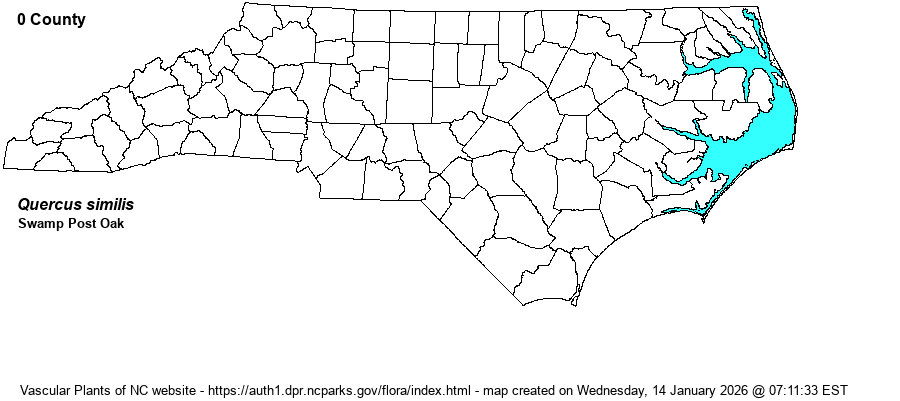| Author | Ashe | |
| Distribution | Included in Weakley's (2020) NC Flora, but with a "?" in the Coastal Plain, and stating the range is from "SC south to GA ...". There are no known NC specimens or reports to a location, and thus the species is clearly SR (State Reported) in our state. In the 2024 version of Weakley's flora, Q. similis is not credited to NC. Thus, ought to be treated as State Reported False.
This is a Southern species occurring mainly in the lower Mississippi Valley region, in LA, AR, and MS. It is very spottily present east to eastern SC and GA, and west to eastern TX.
| |
| Abundance | If present in NC, it is certainly extremely rare; but, for now, it is presumed not present. | |
| Habitat | According to Weakley (2020), this is a species of rich hardwood bottomlands, especially in circumneutral soil. These soils can be flooded from time to time, though it is not really a “swamp” species. Might it occur in Wet Marl Forest natural community in Pender County? | |
| Phenology | Probably flowers in April, and probably fruits from September to November. | |
| Identification | It is assumed to be practically unknown in the field to essentially all NC biologists. It is a medium deciduous tree, growing to perhaps 70-80 feet tall. It has rather thick leaves that are quite shiny and dark green above and gray below. The leaves are somewhat like a “hybrid” between Post Oak (Q. stellata) and Overcup Oak (Q. lyrata), and thus a bit like those of the rare Bluff Oak (Q. austrina). The lobes are somewhat triangular yet rounded and rather irregular, such that the leaves are quite asymmetrical. The leaves of Bluff Oak are glabrous below, whereas those of Swamp Post Oak are rather tomentose. Note that Swamp Post Oak should be found in NC only in very rich, if not calcareous, forested wetlands; Bluff Oak occurs mainly on slopes (though also in high pH soil). Its acorns are somewhat “normal”, as opposed to the almost completely covered acorn (by the cup) in Overcup Oak, which also grows in wet bottomlands. | |
| Taxonomic Comments | A few references seem to simply overlook this species, or include it within Q. stellata without comment or without listing it as a variety. Most recent references do consider it as a valid species. Though there are several SC records, it was not listed in RAB (1968).
| |
| Other Common Name(s) | Bottomland Post Oak, Delta Post Oak | |
| State Rank | SRF | |
| Global Rank | G4 | |
| State Status | | |
| US Status | | |
| USACE-agcp | | |
| USACE-emp | | |

